Separation techniques play an essential role in chemistry, industry, and daily life. These methods allow scientists and engineers to isolate, purify, and analyze different substances based on their physical or chemical properties. Whether extracting essential oils, purifying water, or refining petroleum, separation techniques are indispensable.
The ability to separate mixtures is a crucial aspect of chemistry, employed extensively in both laboratory experiments and industrial applications. Various techniques are designed to isolate individual components based on their distinct physical and chemical properties. This article delves into some of the most effective laboratory separation methods, explaining their principles, procedures, and real-world applications.
Introduction to Separation Techniques
Separation techniques are methods employed to divide mixtures into their individual components. Mixtures can be homogeneous (like solutions) or heterogeneous, necessitating different methods for effective separation. The selection of technique is influenced by the physical properties of the components, including boiling point, solubility, magnetism, and particle size.
Types of Separation Techniques
Separation techniques are the backbone of chemistry, biotechnology, and various industrial processes. These powerful methods allow scientists and industries to isolate, purify, and analyze different substances efficiently. Whether in pharmaceuticals, environmental science, or food production, separation techniques play a crucial role in enhancing quality and precision.
There are several methods used to separate mixtures, depending on the nature of the components. The major techniques include:
1. Filtration
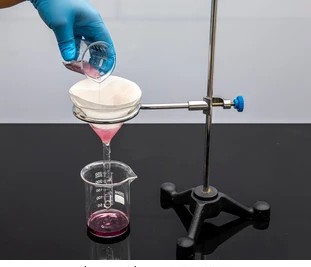
Principle:
Filtration is a widely used technique for separating an insoluble solid from a liquid. This method employs filter paper or a porous membrane to trap solid particles while allowing the liquid to pass through. Common examples include filtering tea leaves from tea and purifying water by removing sediments.
Procedure:
A mixture of an insoluble solid and liquid is poured through a filter medium. The solid particles remain on the filter, forming a residue, while the liquid, known as the filtrate, passes through into a collecting vessel.
Applications:
- Purifying drinking water by removing suspended impurities
- Separating precipitates in chemical reactions
- Clarifying solutions in pharmaceutical production
2. Simple Distillation
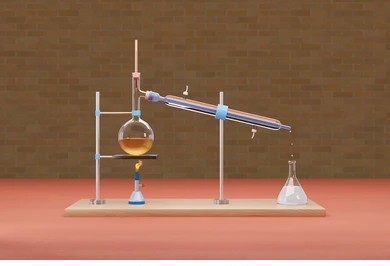
Principle:
Distillation separates liquids according to their boiling points. The mixture is heated until one component evaporates, and then the vapor is condensed back into liquid form. This technique is utilized in the production of alcoholic beverages, the desalination of seawater, and the refining of crude oil.
Procedure:
The mixture is subjected to heat in a distillation apparatus, leading to the vaporization of the component with the lower boiling point first. This vapor is subsequently cooled and converted back into liquid, facilitating its collection in a separate container.
Applications:
- Producing distilled water
- Purification of alcohol in industries
- Separating crude oil fractions in petroleum refining
3. Chromatography
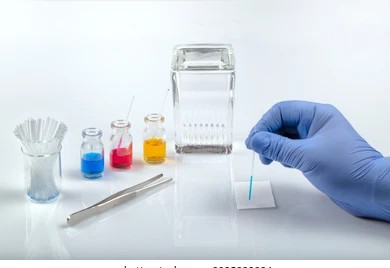
Principle:
Chromatography is an advanced separation technique used for analyzing and purifying compounds. It relies on differences in solubility and interaction with a stationary and mobile phase. This method is commonly used in forensic science, drug testing, and food analysis.
Procedure:
A mixture is introduced into the system, where different components travel at varying speeds due to their interaction with the stationary phase. The separation pattern is analyzed for identification.
Applications:
- Identifying substances in forensic science
- Analyzing food and drug purity
- Detecting pollutants in environmental studies
4. Evaporation

Principle:
Evaporation is used to separate a dissolved solid from a liquid. By heating the solution, the liquid evaporates, leaving behind the solid residue. This technique is widely applied in salt production from seawater.
Procedure:
A saturated solution is prepared and allowed to cool slowly. As the temperature decreases, pure solid crystals form, which are then collected by filtration or decantation.
Applications:
- Producing high-purity salt and sugar
- Manufacturing pharmaceutical drugs
- Extracting pure substances in chemical industries
5. Centrifugation
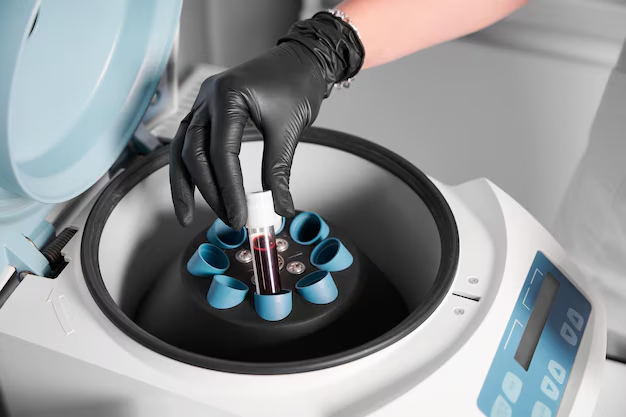
Principle:
Centrifugation is a method that uses rapid spinning to isolate components in a mixture according to their density. During this process, denser particles are forced to the bottom, while less dense substances collect at the top. In medical settings, this technique is commonly applied to separate different elements of blood, such as plasma, red blood cells, and platelets.
Procedure:
A mixture is placed in a centrifuge and spun at high speeds. Denser components migrate outward, forming distinct layers that can be separately collected.
Applications:
- Isolating blood components in medical labs
- Purifying biological samples in research
- Separating cream from milk in dairy industries
6. Magnetic Separation

Principle:
Magnetic separation is ideal for separating magnetic materials from non-magnetic substances. This method is often used in recycling processes to extract ferrous metals from waste.
Process:
- A magnet is used to attract iron, nickel, or cobalt.
- Non-magnetic materials remain behind.
Example: Separating iron filings from sand.
Applications:
- Recycling industry.
- Mining industry.
7. Decantation
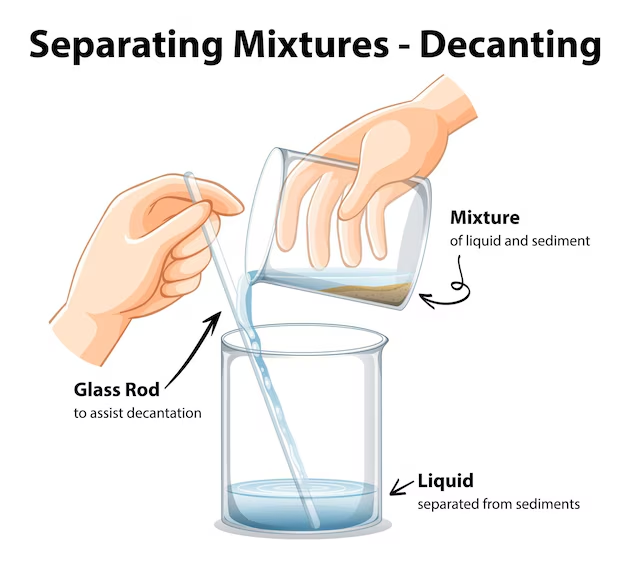
Principle:
Decantation involves carefully pouring a liquid to separate it from a solid or an immiscible liquid. This technique is often used in separating oil from water or removing sediment from wine.
Process:
- The heavier solid settles at the bottom.
- The liquid is carefully poured off.
Example: Separating sand from water.
Applications:
- Oil and water separation.
- Wine decanting.
8. Sublimation

Principle: Certain solids can transition directly from solid to gas without passing through the liquid state.
Process:
- The mixture is heated.
- The sublimable substance changes into a gas.
- It is then cooled and collected as a solid again.
Example: Separation of ammonium chloride from salt.
Applications:
- Purification of iodine.
- Extraction of caffeine.
9. Crystallization
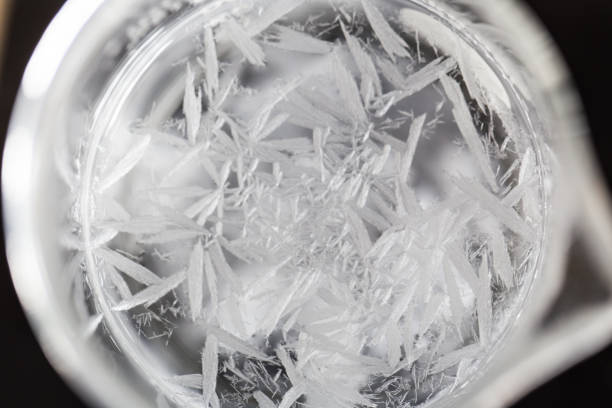
Principle:
Crystallization exploits differences in solubility to purify solid substances. As a solution cools or evaporates, the solute forms well-defined crystals, leaving impurities behind.
Process:
- The solution is heated until some liquid evaporates.
- The saturated solution is cooled, allowing crystals to form.
- The crystals are then filtered and dried.
Example: Purification of sugar.
Applications:
- The pharmaceutical industry for drug purification.
- The food industry for sugar crystallization.
10. Fractional Distillation

Principle: Used to separate two or more liquids with different boiling points.
Process:
- The mixture is heated.
- Vapors rise through a fractionating column.
- The component with the lowest boiling point condenses first and is collected.
- The process continues for other components.
Example: Separation of ethanol and water.
Applications:
- Crude oil refining.
- Production of alcoholic beverages.
Importance of Separation Techniques
Separation techniques are essential in various fields, including chemistry, biology, industry, and environmental science. Here’s why they are important:
1. Purification of Substances
- Separation techniques remove impurities from substances, ensuring they meet required purity levels.
- Example: Distillation is used to purify water and separate alcohol from fermented mixtures.
2. Identification and Analysis
- Scientists use separation techniques to analyze the composition of mixtures.
- Example: Chromatography helps identify the components of a dye, drug, or food additive.
3. Pharmaceutical Industry
- Drug manufacturing requires pure chemicals to ensure safety and efficacy.
- Example: Crystallization is used to purify aspirin.
4. Food Industry
- Separation techniques are used to extract useful components and remove harmful substances.
- Example: Centrifugation is used to separate cream from milk.
5. Environmental Protection
- Helps in removing pollutants from air, water, and soil.
- Example: Filtration is used in water treatment plants to remove solid impurities.
6. Industrial Applications
- Separation techniques play a vital role in oil refining, metal extraction, and chemical production.
- Example: Fractional distillation is used to separate different components of crude oil.
7. Research and Development
- Scientists use separation methods in developing new materials, medicines, and technologies.
- Example: Gel electrophoresis is used in DNA analysis.
Final thought
Separation techniques are fundamental to scientific research and industrial applications. Understanding these methods allows for better resource utilization, improved product quality, and innovative solutions in various sectors. Whether in a laboratory or large-scale industries, mastering separation techniques is key to efficiency and sustainability.
Understanding separation techniques is fundamental for students studying IGCSE Chemistry. These methods have vast real-world applications across various industries, from medicine to environmental science. Mastering these techniques ensures a strong foundation for further scientific studies and careers.
What are the 10 separation techniques in chemistry, IGCSE grade 10th?
Separating mixtures is a fundamental process in chemistry, used in laboratories and industries worldwide. Various separation techniques help isolate components based on their physical and chemical properties. This article explores the most effective laboratory separation methods, detailing their principles, procedures, and applications.
Separation techniques are the backbone of chemistry, biotechnology, and various industrial processes. These powerful methods allow scientists and industries to isolate, purify, and analyze different substances efficiently. Whether in pharmaceuticals, environmental science, or food production, separation techniques play a crucial role in enhancing quality and precision.
Types of Separation Technique
There are several methods used to separate mixtures, depending on the nature of the components. The major techniques include:
1. Filtration
2. Distillation
3. Chromatography
4. Evaporation
5. Centrifugation
6. Magnetic Separation
7. Decantation
8. Evaporation
9. Crystallization
10. Fractional Distillation
Understanding separation techniques is fundamental for students studying IGCSE Chemistry. These methods have vast real-world applications across various industries, from medicine to environmental science. Mastering these techniques ensures a strong foundation for further scientific studies and careers.
What are 5 ways to separate a mixture?
Separating mixtures is a fundamental process in chemistry, used in laboratories and industries worldwide. Various separation techniques help isolate components based on their physical and chemical properties. This article explores the most effective laboratory separation methods, detailing their principles, procedures, and applications.
1. Handpicking
2. Sieving
3. Filtration
4. Evaporation
5. Magnetic Separation
Write about the Importance of Separation Techniques.
Pharmaceutical Industry – Ensuring purity in drug production.
Water Treatment – Removing contaminants for safe drinking water.
Food Industry – Extracting essential ingredients and enhancing food quality.
Environmental Science – Reducing pollution through waste separation.
What is the separation technique of centrifugation?
Centrifugation is a foundational technique in science and industry that leverages centrifugal force generated by rapid rotational motion to separate components of a mixture based on differences in their size, density, shape, or viscosity. This process accelerates the natural sedimentation of particles, enabling efficient separation that would otherwise take hours or days under gravity alone.
Separation techniques are the backbone of chemistry, biotechnology, and various industrial processes. These powerful methods allow scientists and industries to isolate, purify, and analyze different substances efficiently. Whether in pharmaceuticals, environmental science, or food production, separation techniques play a crucial role in enhancing quality and precision.
What is the separation technique of Distillation?
Separation techniques are the backbone of chemistry, biotechnology, and various industrial processes. These powerful methods allow scientists and industries to isolate, purify, and analyze different substances efficiently. Whether in pharmaceuticals, environmental science, or food production, separation techniques play a crucial role in enhancing quality and precision.
Separation techniques are fundamental to scientific research and industrial applications. Understanding these methods allows for better resource utilization, improved product quality, and innovative solutions in various sectors. Whether in a laboratory or large-scale industries, mastering separation techniques is key to efficiency and sustainability.
Importance of Separation Techniques
Separation techniques are vital in various fields, including:
Pharmaceutical Industry – Ensuring purity in drug production.
Water Treatment – Removing contaminants for safe drinking water.
Food Industry – Extracting essential ingredients and enhancing food quality.
Environmental Science – Reducing pollution through waste separation.
Write the importance of Separation Techniques.
1. Purification of Substances
Separation techniques remove impurities from substances, ensuring they meet required purity levels.
Example: Distillation is used to purify water and separate alcohol from fermented mixtures.
2. Identification and Analysis
Scientists use separation techniques to analyze the composition of mixtures.
Example: Chromatography helps identify the components of a dye, drug, or food additive.
3. Pharmaceutical Industry
Drug manufacturing requires pure chemicals to ensure safety and efficacy.
Example: Crystallization is used to purify aspirin.
4. Food Industry
Separation techniques are used to extract useful components and remove harmful substances.
Example: Centrifugation is used to separate cream from milk.
5. Environmental Protection
Helps in removing pollutants from air, water, and soil.
Example: Filtration is used in water treatment plants to remove solid impurities.
6. Industrial Applications
Separation techniques play a vital role in oil refining, metal extraction, and chemical production.
Example: Fractional distillation is used to separate different components of crude oil.
7. Research and Development
Scientists use separation methods in developing new materials, medicines, and technologies.
Example: Gel electrophoresis is used in DNA analysis.
8. Evaporation
Principle: Used to separate a soluble solid from a liquid by evaporating the liquid.
Process:
The solution is heated.
The liquid evaporates, leaving behind the solid solute.
Example: Salt from seawater.
Applications:
Salt production.
Sugar refining processes.
9. Crystallization
Principle: A more refined method than evaporation, used to obtain pure crystals of a soluble solid.
Process:
The solution is heated until some liquid evaporates.
The saturated solution is cooled, allowing crystals to form.
The crystals are then filtered and dried.
Example: Purification of sugar.
Applications:
Pharmaceutical industry for drug purification.
Food industry for sugar crystallization.
10. Fractional Distillation
Principle: Used to separate two or more liquids with different boiling points.
Process:
The mixture is heated.
Vapors rise through a fractionating column.
The component with the lowest boiling point condenses first and is collected.
The process continues for other components.
Example: Separation of ethanol and water.
Applications:
Crude oil refining.
Production of alcoholic beverages.
What are the different separation techniques and their applications in IGCSE Chemistry?
There are several methods used to separate mixtures, depending on the nature of the components. The major techniques include:
1. Filtration

Principle:
Filtration is a widely used technique for separating an insoluble solid from a liquid. This method employs filter paper or a porous membrane to trap solid particles while allowing the liquid to pass through. Common examples include filtering tea leaves from tea and purifying water by removing sediments.
Procedure:
A mixture of an insoluble solid and liquid is poured through a filter medium. The solid particles remain on the filter, forming a residue, while the liquid, known as the filtrate, passes through into a collecting vessel.
Applications:
Purifying drinking water by removing suspended impurities
Separating precipitates in chemical reactions
Clarifying solutions in pharmaceutical production
2. Simple Distillation

Principle:
Distillation separates liquids according to their boiling points. The mixture is heated until one component evaporates, and then the vapor is condensed back into liquid form. This technique is utilized in the production of alcoholic beverages, the desalination of seawater, and the refining of crude oil.
Procedure:
The mixture is subjected to heat in a distillation apparatus, leading to the vaporization of the component with the lower boiling point first. This vapor is subsequently cooled and converted back into liquid, facilitating its collection in a separate container.
Applications:
Producing distilled water
Purification of alcohol in industries
Separating crude oil fractions in petroleum refining
3. Chromatography

Principle:
Chromatography is an advanced separation technique used for analyzing and purifying compounds. It relies on differences in solubility and interaction with a stationary and mobile phase. This method is commonly used in forensic science, drug testing, and food analysis.
Procedure:
A mixture is introduced into the system, where different components travel at varying speeds due to their interaction with the stationary phase. The separation pattern is analyzed for identification.
Applications:
Identifying substances in forensic science
Analyzing food and drug purity
Detecting pollutants in environmental studies
4. Evaporation

Principle:
Evaporation is used to separate a dissolved solid from a liquid. By heating the solution, the liquid evaporates, leaving behind the solid residue. This technique is widely applied in salt production from seawater.
Procedure:
A saturated solution is prepared and allowed to cool slowly. As the temperature decreases, pure solid crystals form, which are then collected by filtration or decantation.
Applications:
Producing high-purity salt and sugar
Manufacturing pharmaceutical drugs
Extracting pure substances in chemical industries
5. Centrifugation

Principle:
Centrifugation is a method that uses rapid spinning to isolate components in a mixture according to their density. During this process, denser particles are forced to the bottom, while less dense substances collect at the top. In medical settings, this technique is commonly applied to separate different elements of blood, such as plasma, red blood cells, and platelets.
Procedure:
A mixture is placed in a centrifuge and spun at high speeds. Denser components migrate outward, forming distinct layers that can be separately collected.
Applications:
Isolating blood components in medical labs
Purifying biological samples in research
Separating cream from milk in dairy industries
6. Magnetic Separation

Principle:
Magnetic separation is ideal for separating magnetic materials from non-magnetic substances. This method is often used in recycling processes to extract ferrous metals from waste.
Process:
A magnet is used to attract iron, nickel, or cobalt.
Non-magnetic materials remain behind.
Example: Separating iron filings from sand.
Applications:
Recycling industry.
Mining industry.
7. Decantation

Principle:
Decantation involves carefully pouring a liquid to separate it from a solid or an immiscible liquid. This technique is often used in separating oil from water or removing sediment from wine.
Process:
The heavier solid settles at the bottom.
The liquid is carefully poured off.
Example: Separating sand from water.
Applications:
Oil and water separation.
Wine decanting.
8. Sublimation

Principle: Certain solids can transition directly from solid to gas without passing through the liquid state.
Process:
The mixture is heated.
The sublimable substance changes into a gas.
It is then cooled and collected as a solid again.
Example: Separation of ammonium chloride from salt.
Applications:
Purification of iodine.
Extraction of caffeine.
9. Crystallization

Principle:
Crystallization exploits differences in solubility to purify solid substances. As a solution cools or evaporates, the solute forms well-defined crystals, leaving impurities behind.
Process:
The solution is heated until some liquid evaporates.
The saturated solution is cooled, allowing crystals to form.
The crystals are then filtered and dried.
Example: Purification of sugar.
Applications:
Pharmaceutical industry for drug purification.
Food industry for sugar crystallization.
10. Fractional Distillation

Principle: Used to separate two or more liquids with different boiling points.
Process:
The mixture is heated.
Vapors rise through a fractionating column.
The component with the lowest boiling point condenses first and is collected.
The process continues for other components.
Example: Separation of ethanol and water.
Applications:
Crude oil refining.
Production of alcoholic beverages.
Importance of Separation Techniques
Separation techniques are essential in various fields, including chemistry, biology, industry, and environmental science. Here’s why they are important:
1. Purification of Substances
Separation techniques remove impurities from substances, ensuring they meet required purity levels.
Example: Distillation is used to purify water and separate alcohol from fermented mixtures.
2. Identification and Analysis
Scientists use separation techniques to analyze the composition of mixtures.
Example: Chromatography helps identify the components of a dye, drug, or food additive.
3. Pharmaceutical Industry
Drug manufacturing requires pure chemicals to ensure safety and efficacy.
Example: Crystallization is used to purify aspirin.
4. Food Industry
Separation techniques are used to extract useful components and remove harmful substances.
Example: Centrifugation is used to separate cream from milk.
5. Environmental Protection
Helps in removing pollutants from air, water, and soil.
Example: Filtration is used in water treatment plants to remove solid impurities.
6. Industrial Applications
Separation techniques play a vital role in oil refining, metal extraction, and chemical production.
Example: Fractional distillation is used to separate different components of crude oil.
7. Research and Development
Scientists use separation methods in developing new materials, medicines, and technologies.
Example: Gel electrophoresis is used in DNA analysis.
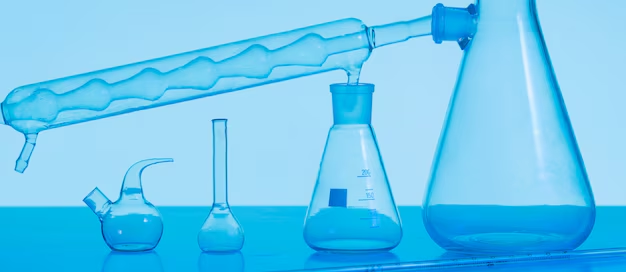
5 thoughts on “Separation Techniques”